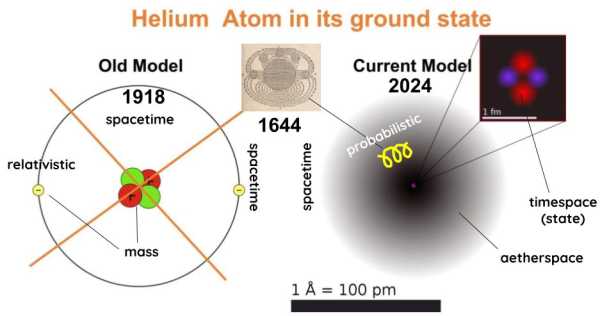The Fine and Hyperfine Structure of the Atom
Bohr’s Quantum Theory Of Line-Spectra Part 2 Section 3 explains the “fine structure” which is based on Sommerfield.
Unlike Newton’s system which is based on mass, Bohr’s system is based on energy states and levels.

The quantum states are consistent with Descartes’ First Law of Motion which is based on the state of the body, which is different from Newton’s First Law which is based on inertia from rest mass.
This whole concept of rest mass is one of the illusions of Nature which Rene Descartes debunked over and over with his explanation of the true nature of motion, rest, and space, which occupies nearly half of Part 2 of Principia Philosophia.
Unlike the solar system, electrons do not follow a sequential orbit around the nucleus. This is because the space inside an atom is the aetherspace.
The Aetherspace Versus Spacetime
Inside the atom, local motion gives way to true motion due to the lack of spacetime particles which are replaced instead by aetherspace particles.
These replace orbits with quantum levels that rely on state. These are consistent with Descartes’ “superficies” which were called gravitational territories in spacetime. In the aetherspace, Physics are called shells.
We can make an analogy with planetary orbits:
| Attribute | Star-Spacetime | Atom-Aetherspace |
|---|---|---|
| Slave | Planet | Electron |
| Slave Action | Rotation Speed from Spacetime | Spin Direction (vortex rotation) from Aetherspace |
| Path | Orbiting Speed from Spacetime | Orbital Speed (Angular Momentum) from Aetherspace |
- The “fine” structure is the relationality* of the electron’s vortex rotation and its orbital speed in the aetherspace.
- The “hyperfine” structure is the relationality of the electron’s vortex rotation, its orbital speed, and the vortex rotation of the nucleus in the aetherspace.
| Structure | Relationality |
|---|---|
| Fine | electron vortex : electron orbital speed : |
| Hyperfine | electron vortex : electron orbital speed : nucleus vortex rotation |
Superphysics Note
Descartes explained spin as the 1st Element (electrons) being vortices manifesting as corkscrews. These can become longer and larger depending on energy. This creates magnetism when they are all aligned, and tunneling in stars (explained in The World Chapter 9).
Lastly, the emission of hydrogen lines as radiowaves or light is a consequence of the wave-particle nature of the 1st Element which Descartes compared to solid grapes and liquid grape juice.
- The more energy is applied to a bunch of grapes, as feet crushing it, the more it will become liquid juice moving away.
- The less energy, the more it becomes solid grapes staying together.
These then dictate how the electron will jump its shells.